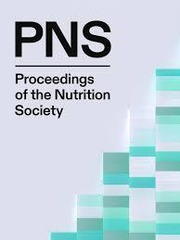No CrossRef data available.
Article contents
Anthropometric characteristics and dietary patterns in people with newly diagnosed Spontaneous coronary artery dissection
Published online by Cambridge University Press: 09 October 2025
Abstract
Spontaneous coronary artery dissection (SCAD) is a non-atherosclerotic cause of ACS that predominately affects middle-aged women with minimal cardiovascular risks(1). Even though SCAD is not associated with poor diets, studies have reported hypertension and dyslipidaemia as common risk factors in SCAD, which could increase their risk of cardiovascular disease(2,3). This study aimed to better understand the health profile of early diagnosed people with SCAD.
Participants took part in three 24-hour dietary recalls (two weekdays and one weekend day), analysed with Nutritics. Body mass, height, and waist circumference were measured by the participants, instructed by the researcher. Data were used to calculate body mass index (BMI) and waist-to-height ratio. Mean% energy of carbohydrate, free sugar, fat, saturated fat (SFA), monounsaturated fat (MUFA), and polyunsaturated fat (PUFA) were compared to dietary reference values (DRVs) using one-sample t-test. A P value <0.05 was regarded significant. This study was approved by Edge Hill University’s Health Research Ethics Committee (ETH2223-0225).
From a total of 48 participants, 31 (30 female and one male) met the inclusion criteria. Mean age (± Standard deviation [SD]) of the participants was 50.2 ± 10.4 years. BMI indicated that 6.5% of participants were underweight, 51.6% had a healthy weight, 29% were overweight, and 12.9% had obesity. Waist-to-height ratio showed that 41.9% of participants had healthy central adiposity, 45.2% had increased central adiposity, and 12.9% had high central adiposity. Mean daily energy intake was 1613.4 ± 506.3 kcal/day. Mean intakes of carbohydrate, free sugar, fibre, fat, SFA, MUFA, PUFA, and sodium were 179.2 ± 61.1 g/day, 14.8 ± 10.7, 20.2 ± 7 g/day, 67.5 ± 24.4 g/day, 22.7 ± 8.40 g/day, 15.7 ± 9.9 g/day, 7.9 g/day ± 5.8, and 1856.7 ± 704.3 mg/day, respectively. Fat, SFA, MUFA, PUFA, carbohydrate and free sugar contributed 37.3 ± 5.2%, 12.2 ± 3.4%, 8.8 ± 4.1%, 5.6 ± 7.5%, 44.5 ± 6.2%, and 4.3 ± 3.43% of total energy, respectively. Fat and SFA were significantly (p <0.001) higher than DRVs of 33% and 10%, respectively. MUFA was significantly (p <0.001) lower than the 12% DRV, whilst PUFA was not significantly different than the 6% DRV (p 0.790). Carbohydrate and fibre were significantly (p <0.001) lower than DRVs of 50% and 30 g/day, respectively. There was no significant difference between free sugar and the 5% DRV (p 0.298).
Cardiometabolic risk linked to adverse anthropometry was prevalent in a large proportion of this cohort. If unaddressed, this may increase risks for developing atherosclerotic cardiovascular disease, which could be accelerated by dietary risk factors associated with increased SFA, reduced fibre and MUFA intake. Future efforts are needed to address cardiovascular risks in SCAD.
Information
- Type
- Abstract
- Information
- Proceedings of the Nutrition Society , Volume 84 , Issue OCE4: Nutrition Society Conference 2025, 1-2 July 2025 , August 2025 , E276
- Copyright
- © The Author(s), 2025. Published by Cambridge University Press on behalf of The Nutrition Society


